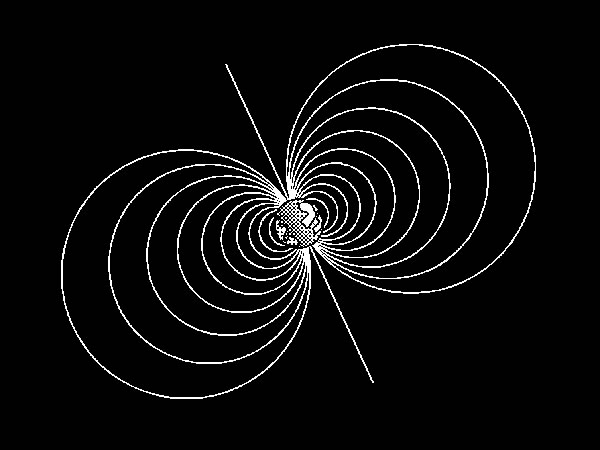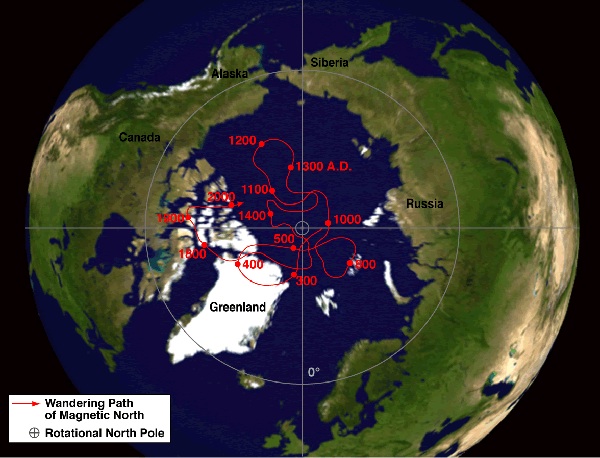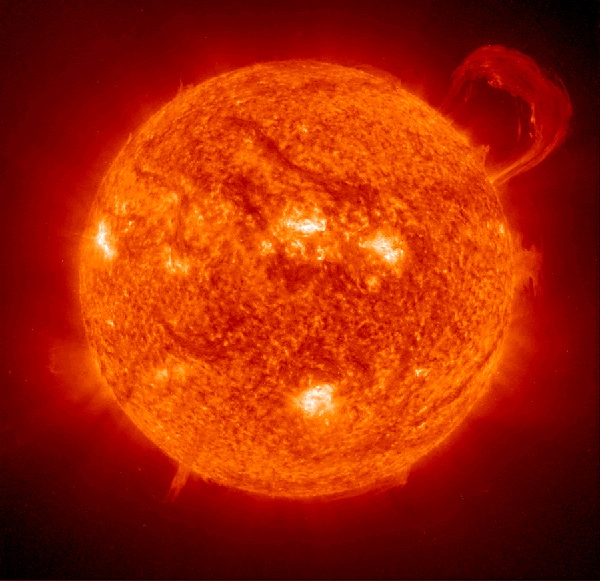A Magnetic Earth Around A Magnetic Sun
VISUAL 19 (still): Symmetric Magnetic Field Idled around Earth

[Fade off Symmetric Magnetic Field.]
The Sun is a magnetic star. And Earth is a magnetic planet!
VISUAL 20 (movie): Magnetic Field of the Earth, Field Detection
[Show and play the video that accompanies the interactive Magnetic Fields activity].
DIGITAL EFFECT: Magnetic Movie
Pause and hide the video. Use playback control functions and chapter markers as needed.
Second Narrator (on Video):
“Here we have a model of the Earth, with magnets at its poles. I’m sure you have all played with magnets before, and know that every magnet has two poles—a positive pole and a negative pole.
“Here we have a ‘field detector.’ It traces the magnetic field of the Earth, starting at one pole, and then going to the other. Notice at the poles, the field sticks straight up out of the Earth, but as you move away from the poles toward the equator, the field is parallel to the surface of the Earth.”Distribute magnetic Earth models and field detectors to groups and allow them time to play with the field detectors and magnetic Earths.
If we take a closer look at exactly where the magnetic poles of the Earth are, we find something interesting. The Positive Pole of the Earth is actually not at the North Pole. The Earth has a pair of geographic poles that are different from its magnetic poles.
VISUAL 21 (still): Wandering Magnetic Pole
[Show an image illustrating the wandering magnetic north pole of the Earth. Then fade off the image. Use playback control functions and chapter markers as needed.]

The geographic North Pole is determined by the spin axis of the Earth, but the magnetic Pole actually wanders around. The red line on this map shows where the magnetic Pole has been for the past 2000 years or so.
The entire magnetic field of the Earth is like a bar magnet. Of course you can’t actually see magnetic field lines, but we can sometimes trace those lines with small magnetic “bits.”
VISUAL 22 (movie): Modeling the Magnetic Field of the Earth[Second Narrator (on Video):
“The magnetic field of the Earth acts like there is a powerful bar magnet at the center of the Earth. Near the poles of the Earth, the field is vertical—which is why the bits tend to stand up at the poles. The field also bunches up at the one pole, and then wraps around the Earth to bunch up at the other pole. Again, at the equator, the field is parallel to the Earth’s axis.”
Distribute field bits (washers) and instruct audience on how to use the kits:Have one person hold the Earth ball, polar axis horizontal.One person should start at the North (Positive) Pole, and stretch their field bits towards the equator.Another person can start at the South (Negative) Pole, and move towards the North chain.They should see the field “gathers” on the Earth’s surface at the poles, but can be stretched out along longitudes. Note that bits will not stick by themselves at the equator. If individuals insist on doing it themselves, have them trade off after each person has made their own field line.
Now let’s think about the magnetic field of the Sun—it’s quite different.
On the Sun, we have sunspots—areas of intense magnetic activity where the “surface” appears dark. Sunspots tend to be found in pairs or clusters. In a sunspot pair, usually one spot has positive magnetic field and the other a negative magnetic field. In a sunspot cluster, each spot has a positive or negative magnetic field, but the cluster overall has about equal amounts of positive and negative magnetic field.
VISUAL 23 (movie): Magnetic Field of a Sunspot, and CME Creation
The field originates beneath the surface of the Sun, and radiates out to the surface at these sunspots. If these loops break, a tremendous amount of energy is released, and can result in a coronal mass ejection—or CME—which is a huge eruption of material from the surface of the Sun. CMEs can carry up to 10 billion tons of plasma, and travel at 1000 km/s, and have the energy equivalent of a billion hydrogen bombs. This energy is then spread across the Solar System.
VISUAL 24 (movie): Modeling the Magnetic Field of the Earth; CME Approaching Earth, Creating Aurora Oval; Aurora
But remember that the Earth has a magnetic field? That violent release of solar energy can reach the Earth and interact with the Earth’s magnetic field and the atmosphere to create TV and radio communication interference. This energy has even been responsible for blackouts! But this interaction also creates other phenomena, like auroras. So, what’s happening on the Sun can affect us here on Earth in many ways.
VISUAL 25 (movie): Magnetic Field of the Sun, Field Detection Second Narrator (on Video):
“Can you tell how these models are different? [Obviously, this model of the Sun is bigger than the Earth. Also the Sun has multiple magnets—representing sunspot groups.
“Unlike the Earth, the Sun as a whole does not act like a giant bar magnet. You can get an idea of what the field is like by again watching our ‘field detector.’ Each sunspot pair acts like a bar magnet.
VISUAL 26 (movie): Modeling the Magnetic Field of the Sun“
Each sunspot pair is like a bar magnet resting on its side, parallel to the surface of the Sun. One member of the pair has a positive-type polarity, the other a negative-type polarity. From these pairs of sunspots, magnetic field loops are formed, and they form at every pair all over the Sun.”
Hold up a Sun magnet model for the audience to see. Exchange Earth models for Sun magnet models and allow time for people to explore the magnetic fields of the Sun models. Encourage audience to create different size loops, and making sure they are forming loops—and not allowing the field to “flatten” between two sunspots. DIGITAL EFFECT: Stop Magnetic Field movie. Use playback control functions and chapter markers as needed.
VISUAL 27 (movie): Modeling the Magnetic Field of the Sun; Sun’s Rotating Magnetic Fields; TRACE Imagery
So, we have magnetic loops all over the Sun, but the Sun’s rotation affects the overall field. This animation shows how the Sun’s magnetic field actually winds up and loops out—warping, twisting, and tangling. These magnetic field loops cause the plasma loops seen on the Sun by satellites, constantly forming, breaking, and changing.
VISUAL 28 (still): Solar Prominences
Show an image illustrating a Solar Prominence. Then, hide the image. Use playback control functions and chapter markers as needed.

From Earth, we can sometimes see the loops on the edge of the Sun’s disc, and we call them prominences. These prominences, like sunspots, are relatively cooler clouds of gas following along magnetic field lines. Sometimes these prominences can even erupt into flares.
All of these phenomena on the Sun are driven by magnetism. The more active the Sun is, the more you can expect to see these phenomena. Observing a lot of sunspots is good indication the Sun is active.
[Collect Sun magnet models and field bits.]

